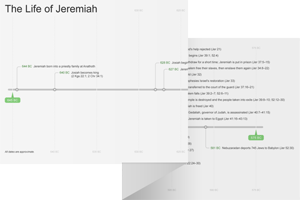27:1–22 This narrative reports Jeremiah’s symbolic action of wearing a yoke, which represents how Judah and the neighboring nations in Syria-Palestine should yield to the rule of Babylon. |
 Symbolic Actions of the Prophets Table
Symbolic Actions of the Prophets Table
27:1 the beginning of the reign of Reigned 597–586 bc. According to 28:1, this was the fourth year of his reign (594/593 bc; see note on 21:1). Most Hebrew manuscripts read “reign of Jehoiakim” here, but this appears to be a scribal error. In v. 3 and 27:12, Jeremiah refers to Zedekiah as the king at the time of this incident.
27:2 fetters and yokes A yoke consisted of a wooden crossbar laid across the necks of a team of oxen and attached with leather straps. See note on Nah 1:13.
put them on your neck Jeremiah wears the yoke; Hananiah later takes it off of him and breaks it (see Jer 28:10).
27:3 Judah’s closest neighbors have sent envoys to Jerusalem to convince Zedekiah to join them in rebellion against Babylon. On the nations listed here, see note on 25:21; note on 25:22. |
send The Hebrew reads “send them,” but this appears to be a typographical error; the verb “send” can be used without an object to indicate sending a message.
27:6 Nebuchadnezzar the king of Babylon, my servant Identifies Nebuchadnezzar as Yahweh’s agent who is carrying out God’s will (see 25:9 and note).
27:7 him, and his son, and his grandson Likely a generic image simply indicating that Babylon’s power would not endure long after Nebuchadnezzar.
27:8 with the sword, and with the famine, and with the plague Punishments linked with divine judgment. See Jer 14:12 and note.
27:9 you must not listen to your prophets The usual role of a prophet in ancient Near Eastern contexts was to tell the king what he wanted to hear, not advise political submission.
You will not serve the king of Babylon The other prophets are telling the kings what they want to hear: that their rebellion will be successful (compare 1 Kgs 22:5–6).
27:11 under the yoke of the king of Babylon Jeremiah offers a choice between submission to Babylon and destruction.
27:12 Zedekiah, the king of Judah Zedekiah receives the same basic message: submit to Babylonian rule and Judah will be spared (see note on Jer 21:1).
27:15 are prophesying in my name falsely Jeremiah adds to the warning given to the other kings, emphasizing to Zedekiah that Yahweh has not sent these prophets, and they are prophesying falsely in Yahweh’s name.
27:16 the vessels of the house of Yahweh Refers to the temple utensils and other portable objects that Nebuchadnezzar carried off in 597 bc (see 2 Kgs 24:8–13). Not only will those things not be returned soon, but Nebuchadnezzar will take the rest of the temple treasures, too (Jer 27:19–22).
27:19 concerning the pillars Nebuchadnezzar apparently left the pillars, the sea, the stands, and other vessels. The front of the temple had two bronze pillars and a huge cast-bronze basin (called the “sea”). The stands also were bronze and held wash basins. All of these things and more miscellaneous bronze items would be taken to Babylon in 586 bc (see 2 Kgs 25:13–18).
27:20 Jeconiah The Hebrew here is yekhonyah (often rendered in English as Jeconiah), which is another name for Jehoiachin. See note on Jer 22:24.

|
About Faithlife Study BibleFaithlife Study Bible (FSB) is your guide to the ancient world of the Old and New Testaments, with study notes and articles that draw from a wide range of academic research. FSB helps you learn how to think about interpretation methods and issues so that you can gain a deeper understanding of the text. |
| Copyright |
Copyright 2012 Logos Bible Software. |
| Support Info | fsb |
 Loading…
Loading…

